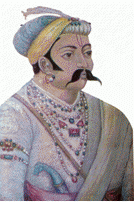History of Rathores
According to Rathore tradition, the clan traces its origins back to the Hindu god, Rama, hero of the epic Ramayana, and thence to the sun. So the Rathores belong to the Suryavansha (solar race) branch of the Kshatriyas, the warrior caste of Hindus. Later, breaking into historical reality, in 470 A.D. Nayal Pal conquered the kingdom of Kannauj, near modern Kanpur in Uttar Pradesh. The Rathore capital for seven centuries, Kannauj fell in 1193 to the Afghan invader’s led by Muhammad Ghori.
The fleeing ruler, Jai Chand, drowned in the Ganga. But his son or grandson, Rao Siyaji, had better luck and Rao Siyaji moved west to the golden sands of the Thar desert. An expedient marriage alliance between the Rathore Siyaji and the sister of a local prince enabled the Rathores to consolidate themselves in this region. In fact, they prospered to such a degree that they managed to oust the Pratiharas of Mandore, nine km to the north of present day Jodhpur. He later set himself up as an independent ruler around the wealthy trading center of Pali, just south of Jodhpur. His descendants flourished, battled often, won often, and in 1381 Rao Chanda ousted the Pratihars from Mandore which then became the Rathore seat of government. Rathore fortunes then turned.
Rao Chanda’s son and heir, Rainmal, won praise for his capture of Ajmer and was then entrusted with the care of his orphaned nephew, destined to inherit the Mewar throne of Chittor. Rainmal may well have had his eyes on this fine, hilltop fort. But court intrigue and treachery stopped him. In 1438 he was doped with opium, and finally shot dead. This triggered bitter feuds, ending with Mewar and Marwar becoming separate states. Rathore legend continues in various versions. One is that Jodha, one of Rainmal’s 24 sons, fled Chittor and finally, 15 years later, recaptured Mandore in 1453. Five years later he was acknowledged as ruler. A holy man sensibly advised him to move his capital to hilltop safety.
By 1459, it became evident that a more secure headquarters was required. The high rocky ridge nine km to the south of Mandore was an obvious choice for the new city of Jodhpur, with the natural enhanced by a fortress of staggering proportions, and to which Rao Jodha’s successors added over the centuries.
Situated atop of a rocky hill 125 m. high, the Jodhpur fort was the mainstay of the princes of Marwar. It has massive, mighty walls and lofty gates. It is the city most closely associated with Rajput valour and the desert beauty of Rajasthan.
The palaces within are noted for their lattice work in red sandstone. They are articulate in design and extreme care has been taken in most to ensure that every possible detail is worked into meticulously. Jodhpur is fast growing to be one of the country’s most visited and photograped destinations, with tourists returning year after year to see the magnificent monuments and palaces, in this city whose architecture has become a sort of monument to human endeavour.
The district of Jodhpur was known as the ancient kingdom of Marwar the land of Death, the largest kingdom in Rajputana and the third largest of the Indian Kingdoms, after Kashmir and Hyderabad. Jodhpur, former capital of Marwar state, retains much of its medieval character. Beginning in 1549, when the city was called Jodhgarh, the Rathore clan of Rajputs fought and ruled from the virtually impregnable fort until their territory covered some 35,000 sq. miles making it the largest Rajput state.
Although there have been numerous invasions into this territory, the Rajputs managed to ward them off very well. The descendants of Rao Jodha Rathore not only ruled Jodhpur but the entire region of Rajasthan all around. The Rajput kingdom of the Rathores was once known as the land of death and universally accepted as an invincible force.


